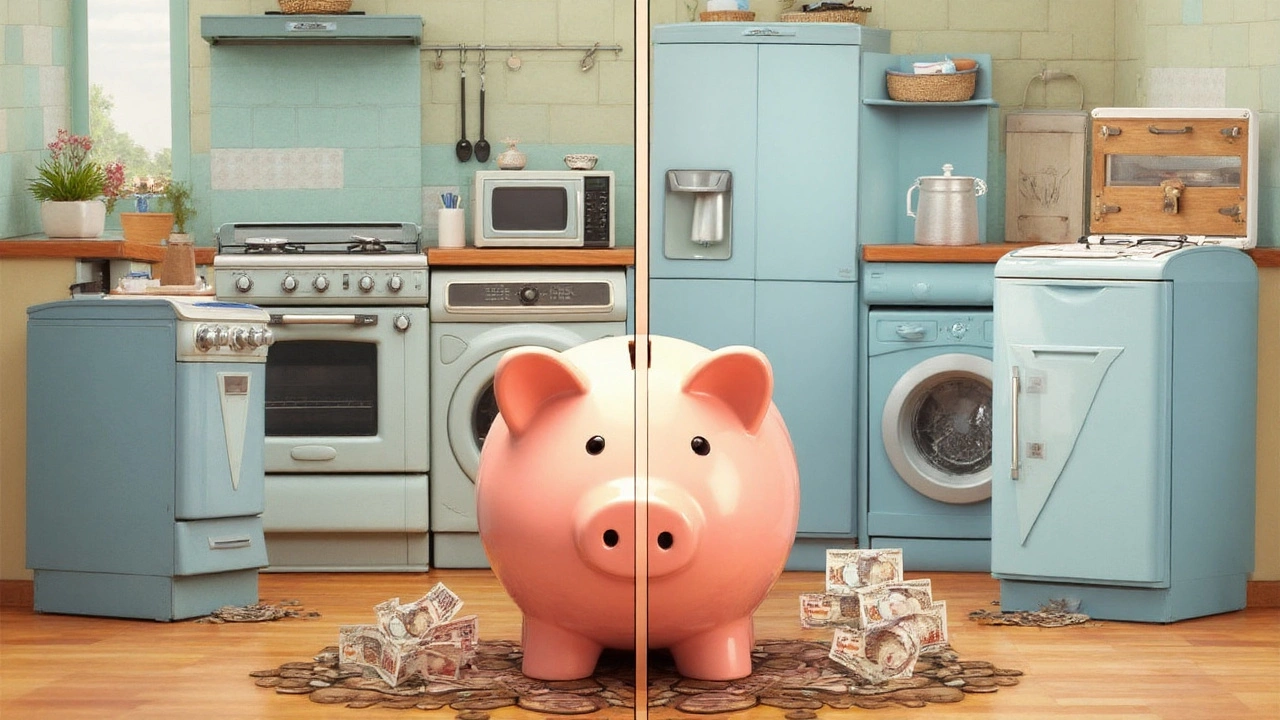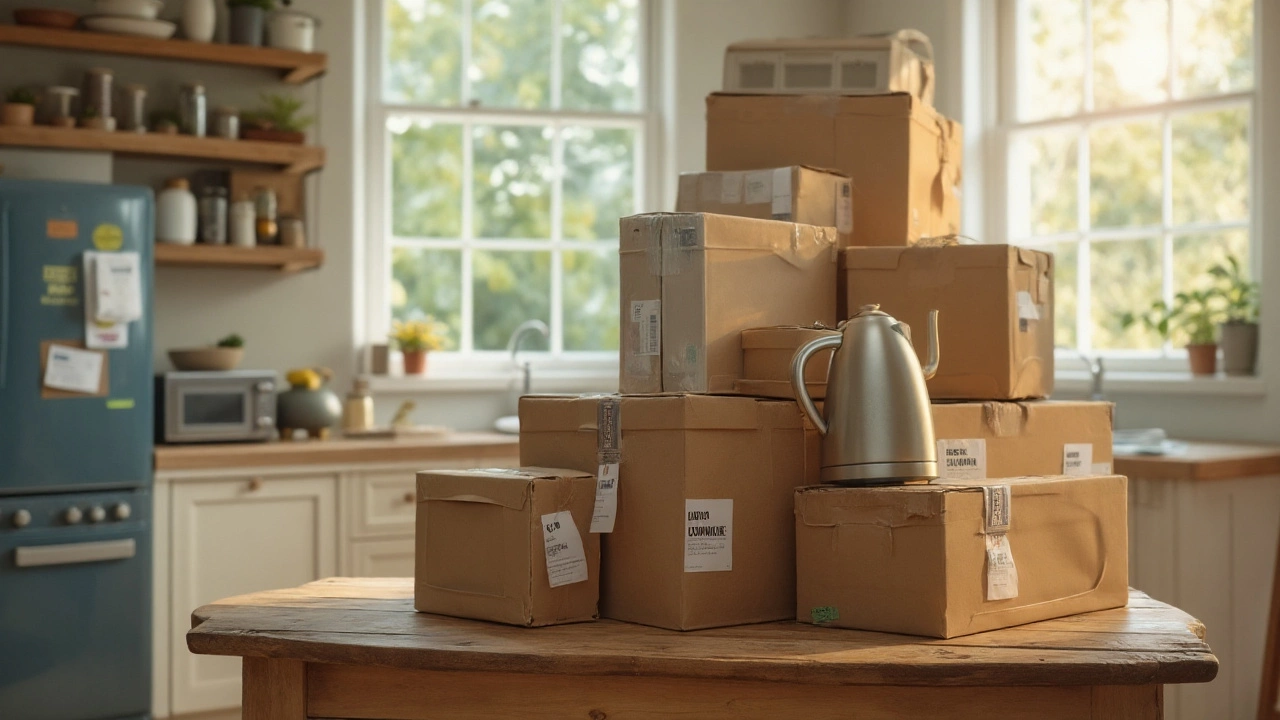Picture this: you're standing in the middle of an appliance store, blinking under fluorescent lights, wondering if you should slap down your credit card for a shiny matching kitchen appliance bundle or hunt for deals one by one. Those bundles always look tempting, lined up and grinning with big red discount tags. But do you actually save cash by bundling? Or are you just getting sucked into a marketing trick?
The Real Numbers: Breaking Down Kitchen Appliance Bundle Costs
Let’s start with the hard data. According to a 2024 appliance market analysis by Statista, the average four-piece major kitchen appliance bundle (refrigerator, oven/range, dishwasher, and microwave) in the US costs about $4,200. On paper, that’s a smooth $800 off compared to buying each item separately from the same brand. Brands like Samsung, LG, and Whirlpool proudly advertise savings anywhere from 10% to 20% when you buy in a bundle during major sales events like Black Friday or Memorial Day.
I asked five appliance sales pros about discounts over the last year. They all shared a similar story: bundles see the deepest discounts during specific months, especially in September and October when new appliance models drop and stores want to clear out last year's stock. Buy during these times, and you can actually walk away with an extra appliance “free” (think microwave tossed in at zero cost), especially if you're flexible on colors or slightly older models.
Below is a comparison pulled from a real 2025 sales circular. Prices are pre-tax, regular retail, and actual bundle discounts advertised in June:
| Item | Buy Individually | Bundle Price |
|---|---|---|
| French Door Refrigerator | $1,800 | $4,200 (total) |
| Gas Range | $1,150 | |
| Dishwasher | $900 | |
| Over-the-Range Microwave | $650 | |
| Total Separate | $4,500 | $4,200 |
On the surface, yes, you’re saving money. Toss in free delivery or a longer warranty and the value ticks up. Here’s the twist: not all bundles are created equal, and you might not always need every item included or even want the specific models offered.
What the Appliance Brands Don’t Tell You
Brands are really smart about how they package bundles. Many only bundle high-volume, mid-range models. That means if you prefer a counter-depth fridge but the bundle includes a deeper, chunky standard, you end up compromising. Brands like KitchenAid and Bosch will sometimes bundle premium items, but these usually come with far less dramatic "bundle" discounts—think $200 off instead of $800.
Another factor: rebates. Stores and manufacturers love to dangle mail-in rebates, but these can trip you up. Miss the rebate deadline, or lose your paperwork, and that extra $200 or $300 in promised savings is gone. Even more confusing, sometimes you’ll find bundles with one or two top-rated appliances paired with a “filler” item—a lower-end microwave or dishwasher just to boost the savings numbers without really giving you all quality gear.
Here's something most salespeople aren't trained to spill: stores may push old models in bundles when a product refresh is around the corner. The newer model might come out with better water-saving features, added WiFi, or slicker design, but you could be stuck with last year’s tech. If you care about matching styles, buying a bundle guarantees everything has the same finish, controls, and handles. But if you’re more practical or don’t mind mixing brands, buying individually opens up a whole world of options—sometimes with better performance or user reviews on specific pieces.

When Bundling Kitchen Appliances Makes Sense
There’re certain situations when going all in on a bundle is a no-brainer. Homeowners doing a full kitchen remodel (think blank slate), first-time buyers outfitting an entire new space, or anyone who just wants to open boxes, plug stuff in, and be done—these folks save time and hassle, plus walk away with a matching set that instantly looks premium. Delivery and installation are often easier to schedule in one go.
Major retailers like Home Depot, Lowe’s, and Best Buy often tack on “bonus” offers for bundlers: extended warranties for cheap, haul-away for the old machines, or double loyalty points. If you time a purchase for a holiday sale, bundle savings stack with clearance deals and storewide discounts. It’s not wild to save more than $1,000 on four or five pieces if you catch all the promos at once—think open-box appliances, floor models, or extra 10% off student or military discounts.
Some pros even recommend reaching out to local independent appliance shops. They can sometimes beat national chain prices if you show them the bundle deal, especially in smaller markets where they want your business over the big boxes. Just be sure you get all the details about returns and warranty support on those sets.
Why Buying Separately Might Work in Your Favor
Now, let’s flip it—buying individually lets you cherry-pick. Maybe you want a top-rated French-door fridge from LG, but you also crave a Bosch dishwasher because it’s whisper-quiet and has a stainless tub. Appliance review sites, like Wirecutter and Consumer Reports, emphasize that rarely does a single brand nail every category. Some fridges clog or run noisy; others run hot water lines better. If you read reviews and hunt down deals, you can score steep markdowns on models that are higher-end than those in standard bundles.
Sometimes, separate deals pop up for a specific model that wipes out any advantage from bundling. Scratch-and-dent sales, liquidation events, and open-box clearances are gold mines. I once got a $2,000 fridge for $800 because it had a tiny dent on the side— nothing you'd see after sliding it between cabinets. When you buy piece by piece, you can upgrade your dishwasher but keep your current oven running, or add a fancy new smart fridge to an older lineup without feeling locked into a whole new suite.
Ever notice how price-matching guarantees rarely extend to bundles? If you want retailers to price match, you’ll need to buy items one at a time. It takes a little hustle, but persistence and a few coupon codes or credit card points can make a difference. Loyalty cards, opening a store credit account (for those who pay off the balance, of course), or even waiting until a brand offers an upgrade program with trade-in value works in your favor.

Smart Tips for Saving Big on Kitchen Appliances
- kitchen appliance bundle: Ask for an itemized price breakdown. If a retailer can’t show this, they may be charging more for one item to inflate savings elsewhere.
- Check seasonal deal calendars. The best months? September, October, and early winter, when older stock clears for new lines.
- Ask for open-box models, floor samples, or scratch-and-dent specials even if bundling.
- Stack deals. Use manufacturer rebates, store points, loyalty programs, and even cashback from credit cards.
- If style is less important, mix and match for performance. A mismatch in stainless steel shades isn’t obvious once everything’s installed.
- Look for package upgrades: Many retailers swap in a better fridge or oven for a small upcharge. There’s no harm in asking.
- Always check the warranty. Bundles sometimes come with longer or aggregated coverage—more peace of mind if multiple items fail.
- Double check delivery costs and return policies. Free delivery isn’t always “free” if you only buy fewer pieces, but in bundles, you’re golden.
- Watch out for hidden installation fees. Ice-maker hookups, range venting, and old appliance haul-away can add to the true cost if they’re not included.
A final twist: supply chain blips, like we saw from 2021-2023, made certain appliances—especially dishwashers and freezers—hard to find in any lineup. Buying individually let you snag in-stock items while you waited for other models to arrive, rather than delaying a whole bundle for months.
To wrap it up, buying all your kitchen appliances in a bundle usually saves money if you grab the right promo or are doing a full setup, and you care about a matched look. You still need to dig through the fine print, compare separate pricing, and use a little negotiation muscle. Picking appliances piece by piece might take more effort, but you could unlock bigger savings if you’re patient, detail-oriented, and don’t mind a mixed set. Whichever path you choose, the real win is walking into your kitchen, hitting that start button, and knowing you made the best choice for your style—and your wallet.

